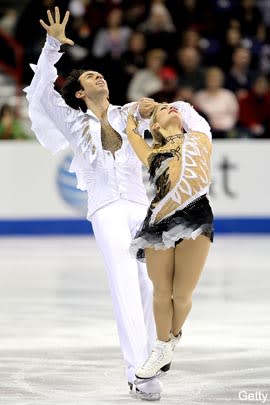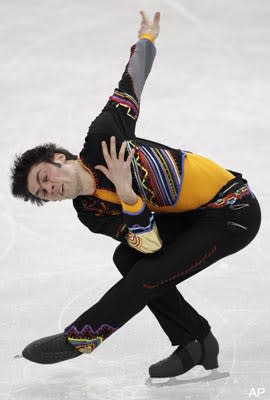Feathers, sequins but no tights: the skinny on figure skating costumes

Figure skating is the only sport at the Olympics Games where costumes play an important role. While costumes aren't judged per se, they are an important part of a skater's packaging. The right costume can enhance a skater's body line or highlight the character they're portraying. Who can forget Katarina Witt's dramatic red Carmen costume, or Nancy Kerrigan's elegant Vera Wang outfits?
Of course, there's a fine line between tasteful and tacky.
In the pairs competition alone, there were crying clowns, "Flash Gordon"-esque bodysuits, and swans. In the men's short program, we watched few matadors, tango dancers, and a sailor or two. Given the parade of funky and fabulous fashions that have hit the ice already, is there anything skaters can't wear?
According the International Skating Union rulebook, "Competitors must be modest, dignified and appropriate for athletic competition – not garish or theatrical in design."
Although there's an abundance of nude-colored illusion fabric or "fake flesh" (particularly among the ice dancers), clothing cannot give the effect of excessive nudity. While figure skating is heavily influenced by ballet, men cannot wear tights, only trousers.

Interestingly, female skaters only recently were allowed to wear pants (either as separates or unitards). Before 2004, skirts were mandatory, and even they had to be a certain length, thanks to Witt.
The German beauty, who won gold in 1984 and 1988, once showed up to a competition in a showgirl costume with some strategically placed feather trim instead of a full skirt.
The judges thought the look was too skimpy and ruled that all costumes must cover the hips and posterior. This became known as the "Katarina Rule" and was repealed when the pants rule was instated for the women. Sleeveless costumes were not allowed until the 90s as well.
Aside from the original dance, props and accessories are also forbidden. Costume violations, while rare, carry a severe penalty. They are a mandatory 1.00 point deduction, the same deduction that skaters receive for a fall. With only fractions of a point separating the podium from the also-rans, no skater will dare risk getting docked.
There's also a safety issue. A skater's blade hitting a wayward sequin or feather can spell disaster. In fact, before a skater takes their starting position, you'll often see them combing the ice with their eyes to look for any tripping hazards.

